An Intelligent Luminance Control Method for Tunnel Lighting Based on Traffic Volume
Abstract
:1. Introduction
2. Tunnel Lighting Control Method Literature Review
3. Demand Luminance for Tunnel Interior
4. Traffic Flow Data Analysis
4.1. Structure of Tunnel Lighting Control System
4.2. Traffic Statistical Analysis of the Chibai Tunnel
5. Proposed Tunnel Lighting Control Method
6. Conclusions
Acknowledgments
Author Contributions
Conflicts of Interest
References
- Roberts, A.C.; Christopoulos, G.I.; Car, J.; Soh, C.K.; Lu, M. Psycho-biological factors associated with underground spaces: What can the new era of cognitive neuroscience offer to their study? Tunn. Undergr. Space Technol. 2016, 55, 118–134. [Google Scholar] [CrossRef]
- Yeung, J.S.; Wong, Y.D. The effect of road tunnel environmental on car following behaviour. Accid. Anal. Prev. 2014, 70, 100–109. [Google Scholar] [CrossRef] [PubMed]
- Salata, F.; Golasi, I.; Poliziani, A.; Futia, A.; de Lieto Vollaro, E.; Coppi, M.; de Lieto Vollaro, A. Management optimization of the luminous flux regulation of a lighting system in road tunnels. A first approach to the exertion of predictive control systems. Sustainability 2016, 8, 1092. [Google Scholar] [CrossRef]
- Ferlazzo, F.; Piccardi, L.; Burattini, C.; Barbalace, M.; Giannini, A.M.; Bisegna, F. Effects of new light sources on task switching and mental rotation performance. J. Environ. Psychol. 2014, 39, 92–100. [Google Scholar] [CrossRef]
- Moretti, L.; Cantisani, G.; Di Mascio, P.; Caro, S. Technical and economic evaluation of lighting and pavement in Italian road tunnels. Tunn. Undergr. Space Technol. 2017, 65, 42–52. [Google Scholar] [CrossRef]
- He, S.; Liang, B.; Pan, G.; Wang, F.; Cui, L. Influence of dynamic highway tunnel lighting environment on driving safety based on eye movement parameters of the driver. Tunn. Undergr. Space Technol. 2017, 67, 52–60. [Google Scholar] [CrossRef]
- Peña-García, A.; Gil-Martín, L.M. Study of pergolas for energy savings in road tunnels. Comparison with tension structures. Tunn. Undergr. Space Technol. 2013, 35, 172–177. [Google Scholar] [CrossRef]
- Gil-Martín, L.M.; Peña-García, A.; Hernández-Montes, E.; Espín-Estrella, A. Tension structures: A way towards sustainable lighting in road tunnels. Tunn. Undergr. Space Technol. 2011, 26, 223–227. [Google Scholar] [CrossRef]
- Abdul Salam, A.O.; Mezher, K.A. Energy saving in tunnels lighting using shading structures. In Proceedings of the 2014 International Renewable and Sustainable Energy Conference (IRSEC), Ouarzazate, Morocco, 17–19 October 2014; pp. 519–524. [Google Scholar]
- Drakou, D.; Burattini, C.; Bisegna, F.; Gugliermetti, F. Study of a daylight “filter” zone in tunnels. In Proceedings of the IEEE International Conference on Environment and Electrical Engineering, Rome, Italy, 10–13 June 2015. [Google Scholar]
- Peña-García, A.; López, J.C.; Grindlay, A.L. Decrease of energy demands of lighting installations in road tunnels based in the forestation of portal surroundings with climbing plants. Tunn. Undergr. Space Technol. 2015, 46, 111–115. [Google Scholar] [CrossRef]
- Qin, X.; Zhang, X.; Qi, S.; Han, H. Design of solar optical fiber lighting system for enhanced lighting in highway tunnel threshold zone: A case study of Huashuyan Tunne in China. Int. J. Photoenergy 2015, 2015, 1–10. [Google Scholar] [CrossRef]
- Lu, Y.X.; Liu, G.G.; Wang, X.; Zhang, Q. A highway tunnel lighting method based on solar energy. Tunnel Constr. 2015, 35, 674–678. [Google Scholar]
- He, Y.; Lang, Z.; Wu, A.; Li, C. Research on intelligent control of tunnel lighting system based on LED. In Proceedings of the 2010 International Conference on Optoleectronics and Image Processing, Haikou, China, 11–12 November 2010; pp. 247–250. [Google Scholar]
- Mao, B.; Niu, P.; Huang, C. The design of the drive control chip for the solar LED lighting system. Modern Appl. Sci. 2008, 2, 75–80. [Google Scholar] [CrossRef]
- Elejoste, P.; Angulo, I.; Perallos, A.; Chertudi, A.; Zuazola, I.J.G.; Moreno, A.; Azpilicueta, L.; Astrain, J.J.; Falcone, F.; Villadangos, J. An easy to deploy street light control system based on wireless communication and LED technology. Sensors 2013, 13, 6492–6523. [Google Scholar] [CrossRef] [PubMed]
- Leccese, F. Remote-Control System of High Efficiency and Intelligent Street Lighting Using a ZigBee Network of Devices and Sensors. IEEE Trans. Power Deliv. 2013, 28, 21–28. [Google Scholar] [CrossRef]
- Nagai, S.; Ishida, S.; Shinji, M.; Nakagawa, K. Energy-saving Lighting System for Road Tunnel. In Proceedings of the Underground Space Use: Analysis of the Past and Lessons for the Future, Istanbul, Turkey, 7–12 May 2005; pp. 625–631. [Google Scholar]
- Li, L. Research on highway tunnel lighting control strategies. Sci. Technol. Assoc. Forum 2008, 2, 46–47. [Google Scholar]
- Duan, W. An intelligent highway tunnel lighting control. J. Changchun Univ. Technol. 2015, 36, 596–600. [Google Scholar]
- Huang, Y.G.; Yan-Ming, N.I.; Lun-Hui, X.U. Tunnel Illuminance Unlimited Dimming Method Based on Fuzzy Control. J. Guangxi Normal Univ. 2011, 29, 10–14. [Google Scholar]
- Ożadowicz, A.; Grela, J. Energy saving in the street lighting control system—A new approach based on the EN-15232 standard. Energy Effic. 2017, 10, 563–576. [Google Scholar] [CrossRef]
- Bellido-Outeiriño, F.J.; Quiles-Latorre, F.J.; Moreno-Moreno, C.D.; Flores-Arias, J.M.; Moreno-García, I.; Ortiz-López, M. Streetlight control system based on wireless communication over DALI protocol. Sensors 2016, 16, 597. [Google Scholar] [CrossRef] [PubMed]
- Fan, S.; Yang, C.; Wang, Z. Automatic Control System for Highway Tunnel Lighting. In Computer and Computing Technologies in Agriculture IV, Proceedings of the 4th IFIP TC 12 Conference, CCTA 2010, Nanchang, China, 22–25 October 2010; Advances in Information and Communication Technology; Springer: Boston, MA, USA, 2010; Volume 347, pp. 116–123. [Google Scholar]
- Carni, D.L.; Grimaldi, D.; Lamonaca, F.; Martirano, L. A smart control to operate the lighting system in the road tunnels. In Proceedings of the IEEE International Conference on Intelligent Data Acquisition and Advanced Computing Systems, Berlin, Germany, 12–14 September 2013; pp. 786–790. [Google Scholar]
- Yi, H.; Li, C.; Wu, A.; Feng, S. LED lighting control system in tunnel based on intelligent illumination curve. In Proceedings of the International Conference on Intelligent Computation Technology & Automation, Huangshan, China, 25–29 July 2012; pp. 698–701. [Google Scholar]
- Commission Internationale de l’Éclairage, CIE. Guide for the Lighting of Road Tunnels an Underpasses; CIE Publication: Vienna, Austria, 2004; Volume 88. [Google Scholar]
- Zeng, H.; Qiu, J.; Shen, X.; Dai, G. Fuzzy Control of LED Tunnel Lighting and Energy Conservation. Tsinghua Sci. Technol. 2011, 16, 576–582. [Google Scholar] [CrossRef]
- Musa, M.S.; Nallagownden, P.; Chiu, K.W.; Sarwar, M.B. Design and development of intelligent adaptive tunnel lighting system. In Proceedings of the IEEE Conference on Energy Conversion, Johor Bahru, Malaysia, 19–20 October 2015; pp. 289–292. [Google Scholar]
- Salata, F.; Golasi, I.; Bovenzi, S.; Vollaro, E.D.L.; Pagliaro, F.; Cellucci, L.; Coppi, M.; Gugliermetti, F.; Vollaro, A.D.L. Energy Optimization of Road Tunnel Lighting Systems. Sustainability 2015, 7, 9664–9680. [Google Scholar] [CrossRef]
- China Communications Press. Guidelines for Design of Lighting of Highway Tunnels; China Communications Press: Beijing, China, 2014; Available online: https://wenku.baidu.com/view/9d69f263bb68a98271fefafa.html (accessed on 26 November 2017).
- Moretti, L.; Cantisani, G.; Di Mascio, P. Management of road tunnels: Construction, maintenance and lighting costs. Tunn. Undergr. Space Technol 2016, 51, 84–89. [Google Scholar] [CrossRef]
- Fan, S.; Li, W. Auto-control System for Highway Tunnel Lighting. J. East China Jiaotong Univ. 2011, 28, 9–13. [Google Scholar]
- Qin, L.; Dong, L.; Xu, W.; Zhang, L.; Yan, Q.; Chen, X. A “vehicle in, light brightens; vehicle out, light darkens” energy-saving control system of highway tunnel lighting. Tunn. Undergr. Space Technol. 2017, 66, 147–156. [Google Scholar] [CrossRef]
- Daely, P.T.; Reda, H.T.; Satrya, G.B.; Kim, J.W.; Shin, S.Y. Design of smart LED streetlight system for smart city with web-based management system. IEEE Sens. J. 2017, 17, 6100–6110. [Google Scholar] [CrossRef]
- Todorović, B.M.; Samardžija, D. Road lighting energy-saving system based on wireless sensor network. Energy Effic. 2017, 10, 239–247. [Google Scholar] [CrossRef]
- Masek, P.; Masek, J.; Frantik, P.; Fujdiak, R.; Ometov, A.; Hosek, J.; Andreev, S.; Mlynek, P.; Misurec, J. A harmonized perspective on transportation management in smart cities: The novel IoT-driven environment for road traffic modeling. Sensors 2016, 16, 1872. [Google Scholar] [CrossRef] [PubMed]
- Castañeda, J.N.; Jelaca, V.; Frías, A.; Pižurica, A.; Philips, W.; Cabrera, R.R.; Tuytelaars, T. Non-Overlapping Multi-camera Detection and Tracking of Vehicles in Tunnel Surveillance. In Proceedings of the International Conference on Digital Image Computing: Techniques and Applications, Noosa, Australia, 6–8 December 2011; pp. 591–596. [Google Scholar]
- Rios-Cabrera, R.; Tuytelaars, T.; Gool, L.V. Efficient multi-camera vehicle detection, tracking, and identification in a tunnel surveillance application. Comput. Vis. Image Underst. 2012, 116, 742–753. [Google Scholar] [CrossRef]
- Marino, F.; Leccese, F.; Pizzuti, S. Adaptive Street Lighting Predictive Control. Energy Procedia 2017, 111, 790–799. [Google Scholar] [CrossRef]
- Wei, Z.; Lu, Q.; Shang, Y. Analysis of Traffic Flow Characteristics under Large Volume in Highway Tunnel Group Region. In Proceedings of the International Conference on Remote Sensing, Environment and Transportation Engineering, Nanjing, China, 1–3 June 2012; pp. 1–5. [Google Scholar]
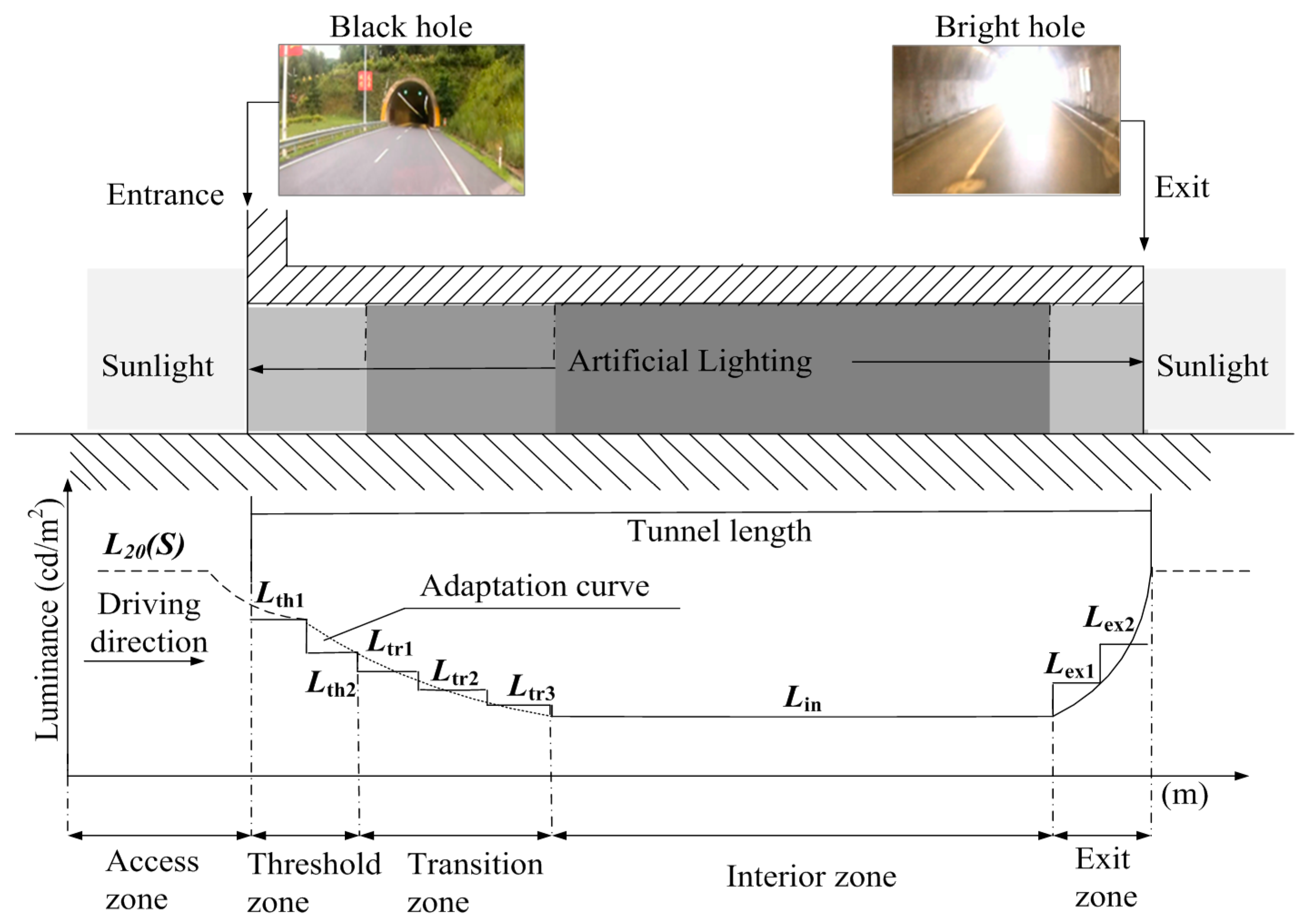


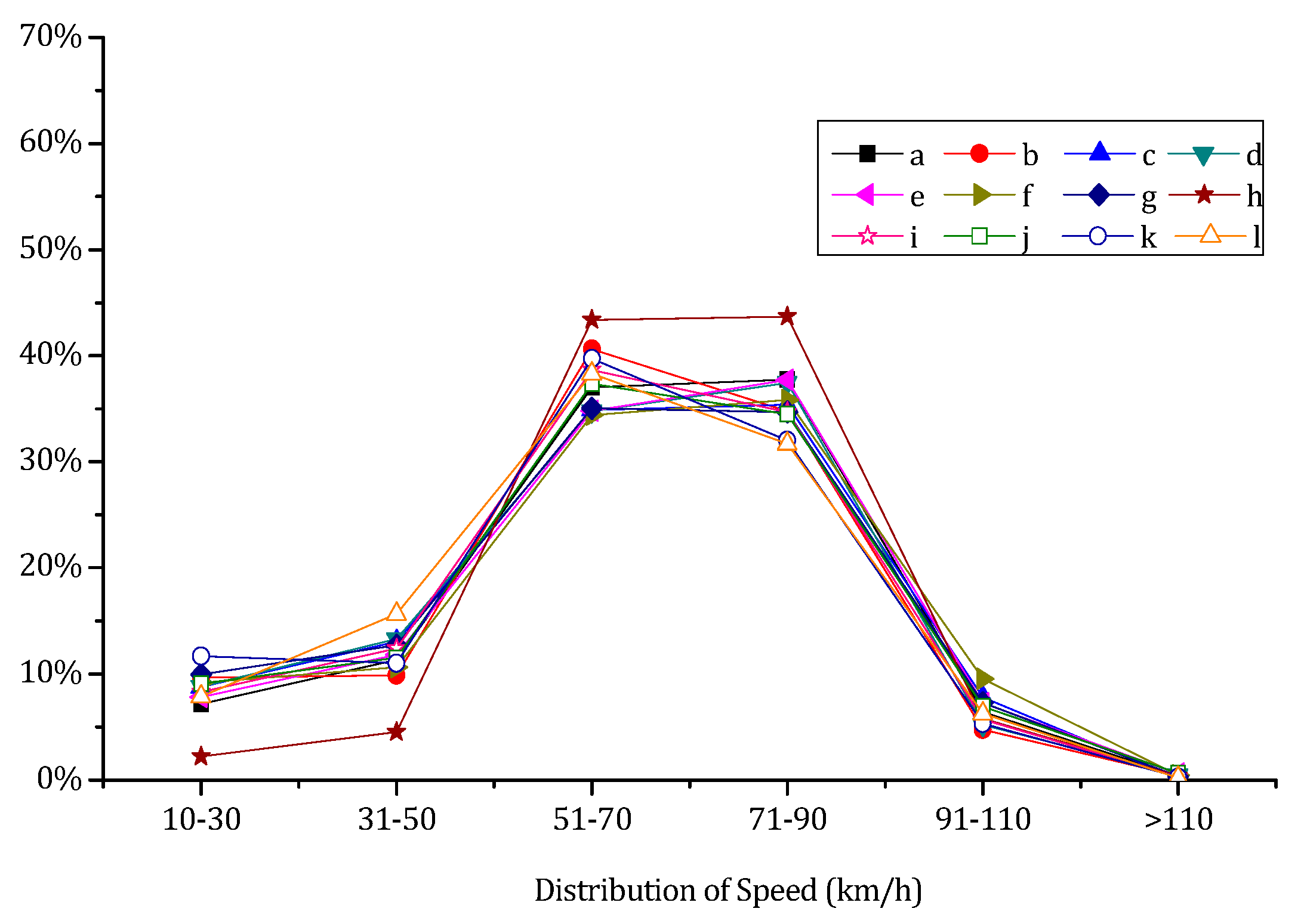

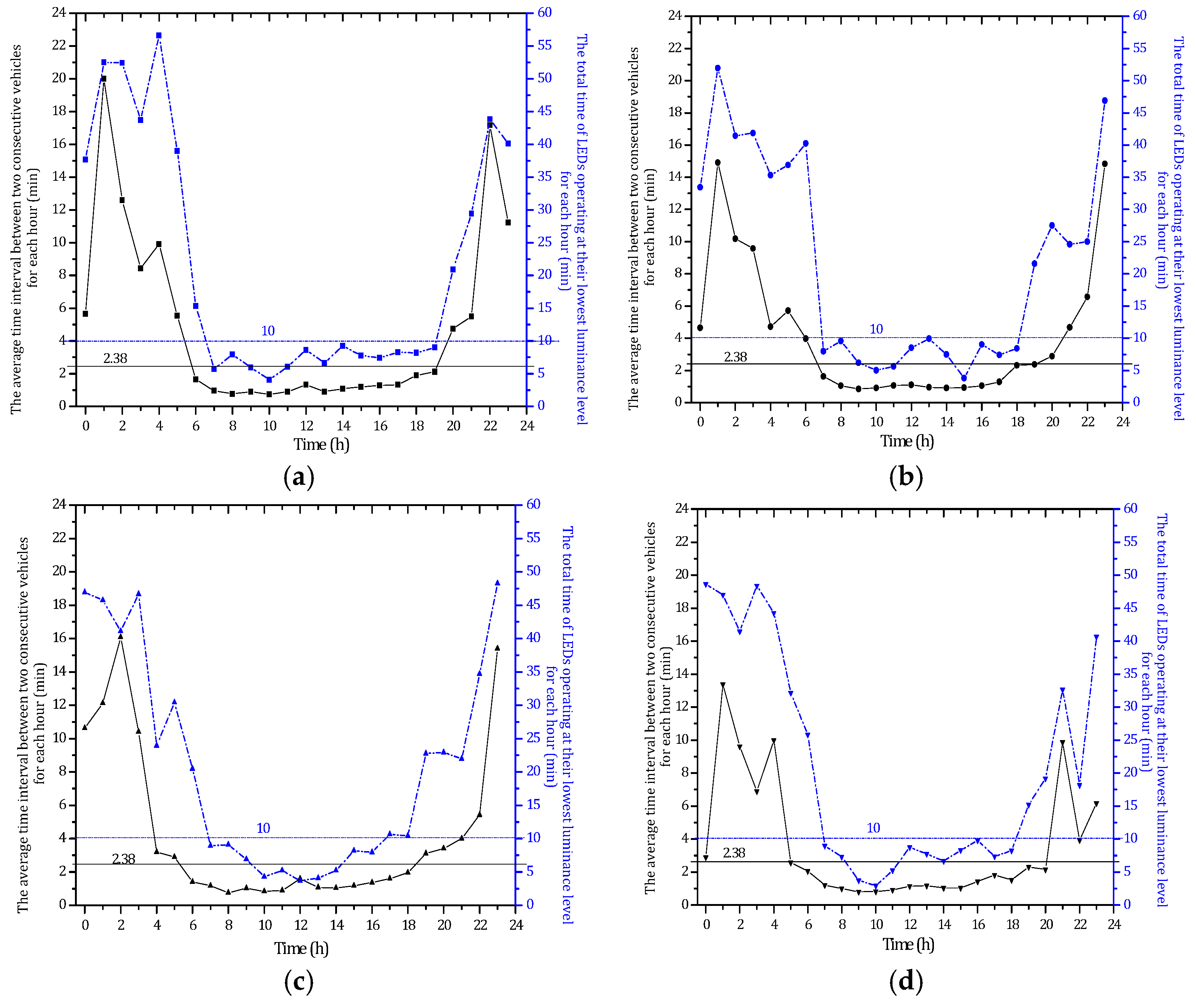
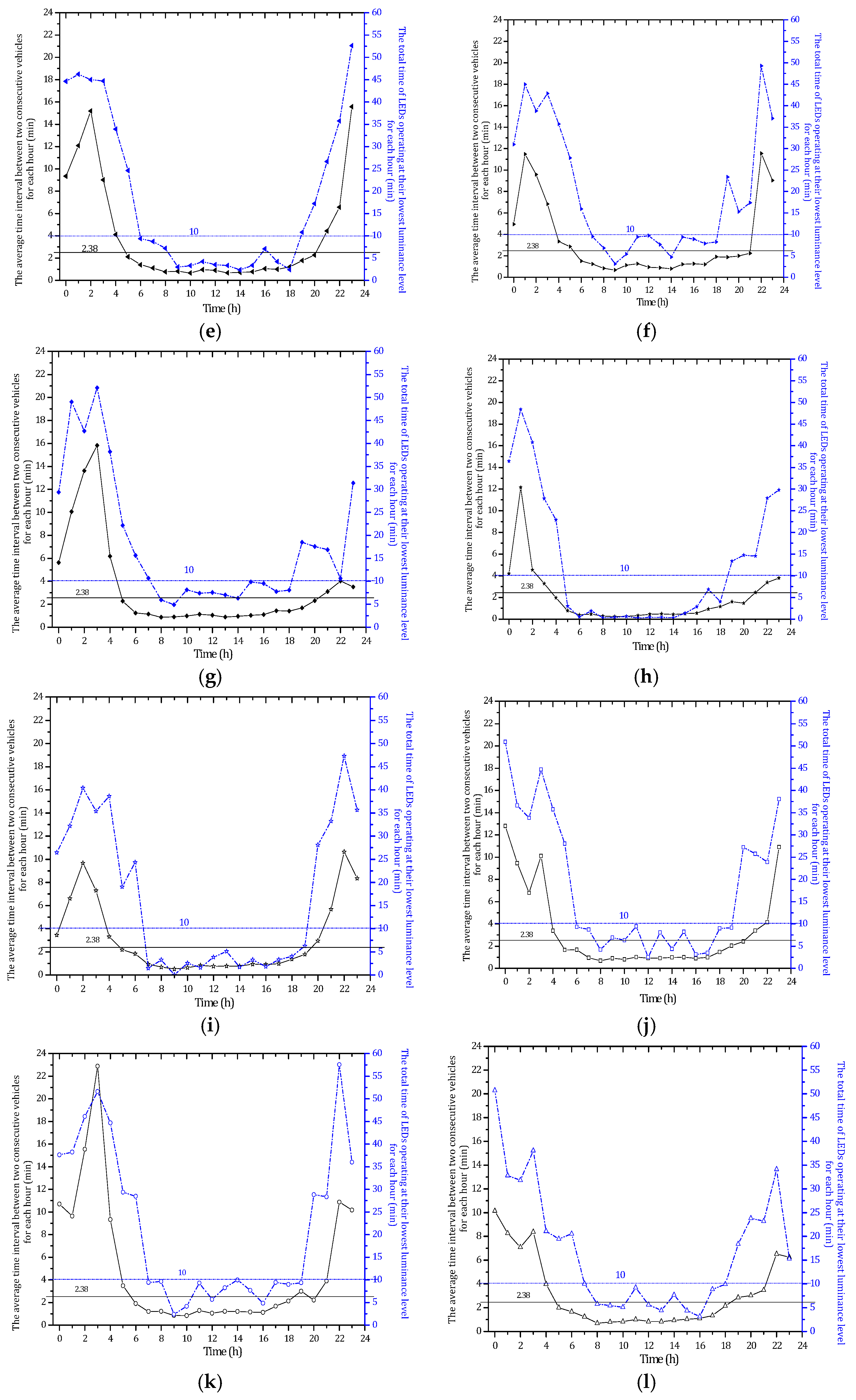
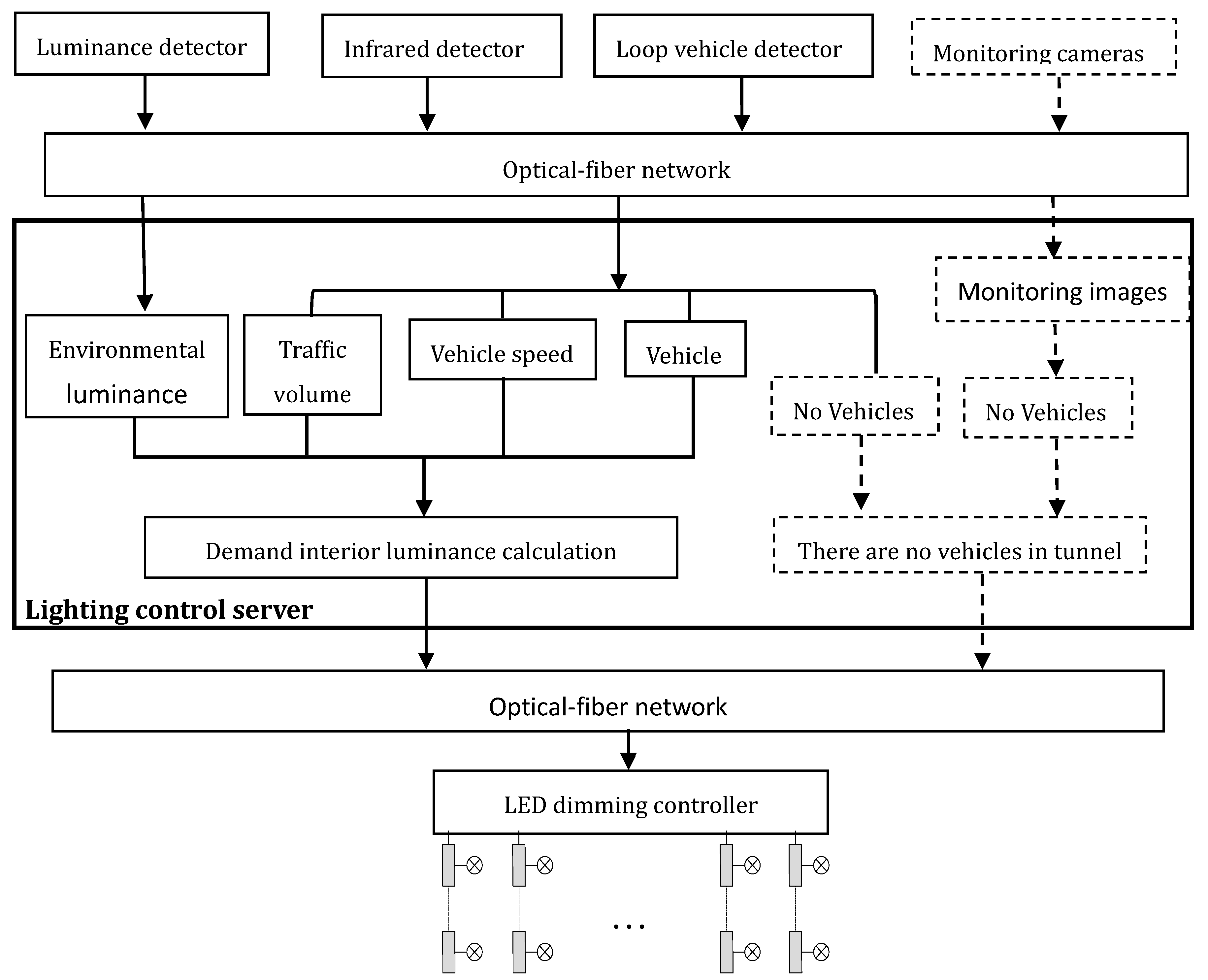
| Tunnel Section | Luminance (cd/m2) |
|---|---|
| Threshold zone 1 | |
| Threshold zone 2 | |
| Transition zone 1 | |
| Transition zone2 | |
| Transition zone 3 | |
| Interior zone | |
| Exit zone 1 | |
| Exit zone 2 |
| Figure | TP1 Less Than 2.38 min | TP2 Less Than 10 min |
|---|---|---|
| Figure 6a | 6:00 a.m.~7:00 p.m. | 7:00 a.m.~7:00 p.m. |
| Figure 6b | 7:00 a.m.~6:00 p.m. | 7:00 a.m.~6:00 p.m. |
| Figure 6c | 6:00 a.m.~6:00 p.m. | 7:00 a.m.~6:00 p.m. |
| Figure 6d | 5:00 a.m.~8:00 p.m. | 7:00 a.m.~6:00 p.m. |
| Figure 6e | 5:00 a.m.~8:00 p.m. | 6:00 a.m.~6:00 p.m. |
| Figure 6f | 6:00 a.m.~9:00 p.m. | 7:00 a.m.~6:00 p.m. |
| Figure 6g | 5:00 a.m.~8:00 p.m. | 7:00 a.m.~6:00 p.m. |
| Figure 6h | 4:00 a.m.~9:00 p.m. | 5:00 a.m.~6:00 p.m. |
| Figure 6i | 5:00 a.m.~7:00 p.m. | 7:00 a.m.~7:00 p.m. |
| Figure 6j | 5:00 a.m.~8:00 p.m. | 6:00 a.m.~7:00 p.m. |
| Figure 6k | 6:00 a.m.~6:00 p.m. | 7:00 a.m.~7:00 p.m. |
| Figure 6l | 5:00 a.m.~6:00 p.m. | 7:00 a.m.~6:00 p.m. |
© 2017 by the authors. Licensee MDPI, Basel, Switzerland. This article is an open access article distributed under the terms and conditions of the Creative Commons Attribution (CC BY) license (http://creativecommons.org/licenses/by/4.0/).
Share and Cite
Qin, L.; Dong, L.-L.; Xu, W.-H.; Zhang, L.-D.; Leon, A.S. An Intelligent Luminance Control Method for Tunnel Lighting Based on Traffic Volume. Sustainability 2017, 9, 2208. https://doi.org/10.3390/su9122208
Qin L, Dong L-L, Xu W-H, Zhang L-D, Leon AS. An Intelligent Luminance Control Method for Tunnel Lighting Based on Traffic Volume. Sustainability. 2017; 9(12):2208. https://doi.org/10.3390/su9122208
Chicago/Turabian StyleQin, Li, Li-Li Dong, Wen-Hai Xu, Li-Dong Zhang, and Arturo S. Leon. 2017. "An Intelligent Luminance Control Method for Tunnel Lighting Based on Traffic Volume" Sustainability 9, no. 12: 2208. https://doi.org/10.3390/su9122208






